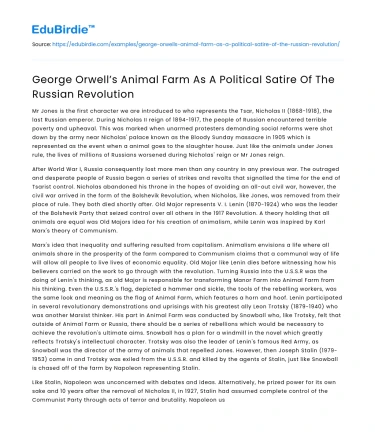Mr Jones is the first character we are introduced to who represents the Tsar, Nicholas II (1868-1918), the last Russian emperor. During Nicholas II reign of 1894-1917, the people of Russian encountered terrible poverty and upheaval. This was marked when unarmed protesters demanding social reforms were shot down by the army near Nicholas' palace known as the Bloody Sunday massacre in 1905 which is represented as the event when a animal goes to the slaughter house. Just like the animals under Jones rule, the lives of millions of Russians worsened during Nicholas' reign or Mr Jones reign.
After World War I, Russia consequently lost more men than any country in any previous war. The outraged and desperate people of Russia began a series of strikes and revolts that signalled the time for the end of Tsarist control. Nicholas abandoned his throne in the hopes of avoiding an all-out civil war, however, the civil war arrived in the form of the Bolshevik Revolution, when Nicholas, like Jones, was removed from their place of rule. They both died shortly after. Old Major represents V. I. Lenin (1870-1924) who was the leader of the Bolshevik Party that seized control over all others in the 1917 Revolution. A theory holding that all animals are equal was Old Majors idea for his creation of animalism, while Lenin was inspired by Karl Marx's theory of Communism.
Save your time!
We can take care of your essay
- Proper editing and formatting
- Free revision, title page, and bibliography
- Flexible prices and money-back guarantee
Marx's idea that inequality and suffering resulted from capitalism. Animalism envisions a life where all animals share in the prosperity of the farm compared to Communism claims that a communal way of life will allow all people to live lives of economic equality. Old Major like Lenin dies before witnessing how his believers carried on the work to go through with the revolution. Turning Russia into the U.S.S.R was the doing of Lenin's thinking, as old Major is responsible for transforming Manor Farm into Animal Farm from his thinking. Even the U.S.S.R.'s flag, depicted a hammer and sickle, the tools of the rebelling workers, was the same look and meaning as the flag of Animal Farm, which features a horn and hoof. Lenin participated in several revolutionary demonstrations and uprisings with his greatest ally Leon Trotsky (1879-1940) who was another Marxist thinker. His part in Animal Farm was conducted by Snowball who, like Trotsky, felt that outside of Animal Farm or Russia, there should be a series of rebellions which would be necessary to achieve the revolution's ultimate aims. Snowball has a plan for a windmill in the novel which greatly reflects Trotsky's intellectual character. Trotsky was also the leader of Lenin's famous Red Army, as Snowball was the director of the army of animals that repelled Jones. However, then Joseph Stalin (1979-1953) come in and Trotsky was exiled from the U.S.S.R. and killed by the agents of Stalin, just like Snowball is chased off of the farm by Napoleon representing Stalin.
Like Stalin, Napoleon was unconcerned with debates and ideas. Alternatively, he prized power for its own sake and 10 years after the removal of Nicholas II, in 1927, Stalin had assumed complete control of the Communist Party through acts of terror and brutality. Napoleon used dogs like Stalin used his KGB which was his secret police that he used to eliminate all opposition or threat to his power. As the novel moves on, Napoleon gains control under the appearance of improving the animals' lives just like Stalin used a great deal of propaganda which was symbolized by Squealer in the novel to show himself as an idealist striving for change. His plan to build the windmill which snowball thought of reflects Stalin's Five-Year Plan for his vision of the nation's industry and agriculture. In the end though, it is thanks to animals like Boxer who swallow all of their leader's lies, that Stalin and Napoleon can become one of the world's most feared and brutal dictators. There is much that Orwell humiliates of the Russian revolution and events around it that comparisons could go on for much longer.
However, numerous events in the novel that are based on ones that occurred during Stalin's rule can quickly be shown off there worth in the book. First, The Battle of the Cowshed parallels the Civil War that occurred after the 1917 Revolution. Frederick represents Adolf Hitler (1889-1945), who allied with Stalin in 1939 but then backstabbed Russia finding himself fighting Stalin's army in 1941. This happened because Frederick appeared like an ally of Napoleon's, but he forged banknotes revealing his true character. The confessions and executions of the animals reflect the various purges and show trials that Stalin conducted to rid himself of any possible threat of dissension. The Battle of the Windmill reflects the U.S.S.R.'s involvement in World War II specifically the Battle of Stalingrad in 1943 when Stalin's forces defeated Hitler's as Napoleon's defeat Frederick.
Finally, the card game at the novel's end parallels the Tehran Conference (November 28-December 1, 1943), where Stalin, Winston Churchill, and Franklin D. Roosevelt met to discuss the ways to forge a lasting peace after the war. Just like everything, this peace, Orwell mocks by having Napoleon and Pilkington complement each other and then betray their other natures by cheating in the card game.






 Stuck on your essay?
Stuck on your essay?

